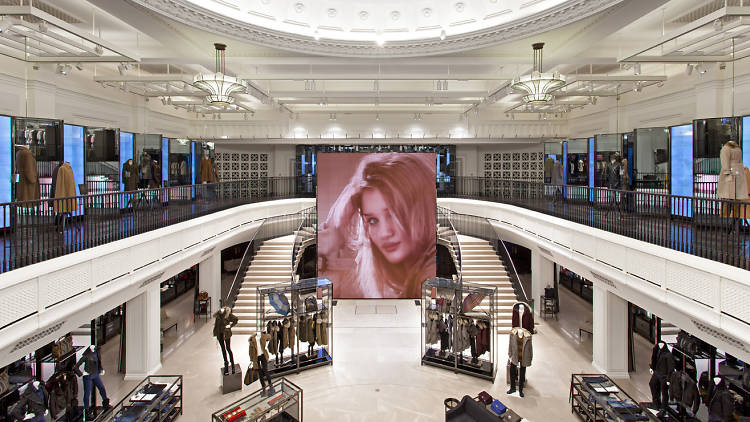The 700-year-old Grand Bazaar in Istanbul, one of the world’s first shopping malls, might seem to be — figuratively and literally — a different world than Burberry, the renowned U.K. fashion house. After all, the Grand Bazaar goes back to the Ottoman Empire , while Burberry is a much-lauded leader in using technology innovation to engage with potential customers and sell the latest fashion.
In a recent post , I explained how rug merchants in the Grand Bazaar used Big Data to segment customers and create a highly personalized experience that delights and surprises them. And that is precisely what Burberry does. Last year, Burberry revamped its flagship store in London (pictured) making it a digitally integrated showroom that also delights and surprises customers.
At the Grand Bazaar, the merchants lovingly showed me their gorgeous Turkish rugs, explaining how they were made. At Burberry, customers can pick up a garment that is fitted with an RFID (radio identification) tag and trigger an interactive video that shows how the product was made or what other items complement it.
Angela Ahrendts, CEO of Burberry, says this gives in-store customers access to the rich levels of immediate information they have grown to expect from the online experience. “Walking through the doors is just like walking into our web site,” she says.
To me, that just shows how much Big Data can break down barriers and create a personalized experience in any shopping environment. While Ahrendts compares it to the web, it also demonstrates how the largest merchants can interact with customers with the same familiarity as the gregarious rug merchants at the Grand Bazaar, who inquire about your family and serve you tea.
At the Grand Bazaar, rug merchants ask clever questions — “Are you here on your honeymoon? Which hotel are you staying at?” — to build an immediate profile of their customer, comparing the answers to their interaction with thousands of customers in the past. The rug merchants can analyze the customers in real-time and create a finely honed and personal shopping experience.
At Burberry, the same thing is happening because of the retailer’s use of Big Data. Customer profiles are built based on what garments the customers have tried on (they are tracked using those RFID tags — with the customers’ permission, of course). Burberry recently launched a program called Customer 360, a data-driven shopping experience which invites customers to digitally share their buying history, shopping preferences and fashion phobias. The program relies on SAP HANA platform — which can analyze huge amounts of data quickly — to analyze customer likes and tastes and deliver that information to employees on the sales floor via their tablet devices. Sales associates who are assisting customers can also access information about their past purchases on a tablet computer.
John Douglas, chief technology officer of Burberry, explains how this works using the example of a fashionable shopper named Natasha, who takes a break from a conference in a distant city to browse through a Burberry store. The salesperson can greet her by name and use a tablet device to make recommendations using predictive analytics fueled by Natasha’s buying history, Twitter posts and fashion industry trend data.
Natasha can examine raincoats that appear on the salesperson’s screen and then view videos of those coats. If she sees a garment she likes, the salesperson can use the device to instantly determine if the coat is in a store near Natasha’s hometown and arrange for it to be shipped to her or reserved for in-store pickup.
Compare that to the rug merchant at the Grand Bazaar and the similarities are clear.
Burberry says its approach is turning the traditional business models upside down. While that’s true among Western retailers, the same model has been applied for centuries at the Grand Bazaar. Today retailers are betting big on technology to help them deliver better engagement with the consumers and deliver a personalized and satisfying shopping experience at a large scale, in store or on the web.
The rug merchants have learned how to make the intimidating experience of the Bazaar comfortable and personal, just as Burberry has learned to make the experience of going to a high-end luxury shop — where products were historically kept behind glass — comfortable and personal.
It just shows that Big Data, at its core, really isn’t a brand new trend, as much as an age-old, tested approach that merchants have unknowingly been using since the Ottoman Empire.
